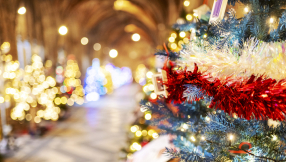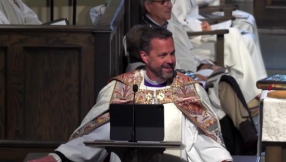
The Christmas tree is not in the Bible but is rooted in Christian symbolism. This is the story...
Trees in the Bible
While the Christmas tree is not mentioned in the Bible, other trees hold great significance in key parts of the Bible. Many types of trees are mentioned in Scripture particularly the oak, cedar, palm, fig, olive, tamarisk and sycomore-fig trees. The Bible even starts and finishes with trees.
Trees in the Old Testament
In the beginning, God planted all kinds of trees (Genesis 2:9). In the middle of the Garden of Eden he planted the tree of life and the tree of knowledge (Genesis 2:16-17), which led to sin coming into the world. In God's plan, the family tree of Jesus weaves through the Old Testament. Jesse was the father of King David and Jesus was his descendant. A verse sometimes quoted at Christmas is "And there shall come forth a rod out of the stem of Jesse, and a Branch shall grow out of his roots:" (Isaiah 11:1 KJV).
Trees in the New Testament
Trees play an important role in the life of Jesus. Jesus grew up in a carpenter craftsman's home (Matthew 13:55, Mark 6:24), so he knew about working with wood from trees. He talked about good trees bearing good fruit and bad trees bearing bad fruit (Matthew 7:17). He talked about seeds of faith, and said that the kingdom of heaven was like a mustard tree (Matthew 13:31-32). Zacchaeus climbed a sycamore-fig tree to get a better view of Jesus (Luke 19:1-4). Jesus prayed among olive trees in the Garden of Gethsemane before the crucifixion (Matthew 26:26).
The tree is then used as an analogy of the cross. In the epistles Jesus is described as dying for us on a tree (Galatians 3:13 and 1 Peter 2:24). It is through this tree that we are offered eternal life, represented by the tree of life, mentioned at the end of the Bible (Revelation 22:14).
St Boniface
The story of the Christmas tree is rooted in Christian history. It is linked to a Devonian missionary called Wynfrith or Winfred. He was from Devon in the former kingdom of Wessex, in south-west England. He is reputed to have been born in Crediton about AD 680, and studied at the Benedictine monastery in Exeter. In 716, he left Wessex and went as a missionary to Frisia, also called Friesland, which was the coastal area of what is now northern Germany and the Netherlands. The Frisian language was similar to the Anglo-Saxon, or Old English language, so it would have been easy to converse, although it is a minority language today.
Pope Gregory II gave Wynfrith the name of Boniface (named after the legendary 4th century Saint Boniface of Tarsus). He travelled around the Germanic tribes, who then worshipped pagan Teutonic gods like Woden (in German Wotan) and Thor (in German Donar). In 722, Boniface was consecrated as an apostolic evangelising bishop to preach to the heathen Germans who lived east beyond the River Rhine. At the time, Boniface was considered to be the greatest missionary since St Paul, and is known as the Apostle of Germany, or the Apostle to the Germans.
Symbolism of the Christmas tree
The story that has been handed down relates an incident which happened in the early 720s, when Boniface came to a place called Geismar, near Hesse. Here he found the locals worshipping an ancient sacred oak tree. Boniface started to chop down the great tree, when a great wind finished the job for him, and blew the tree over and branches lay on the ground in the shape of a cross. The locals waited for Thor to strike Boniface by lightning, but nothing happened. Instead, the people were amazed and listened to Boniface and converted to Christianity, and the people later built a church out of the wood.
The traditional story goes that a small fir tree grew up in the place of the pagan sacred oak. Boniface, perhaps cognisant of the biblical symbolism of trees, used this as an opportunity to tell the Gospel message. He is supposed to have explained that the new fir tree represented new life, its evergreen leaves symbolised the everlasting love of God, the branches represented the cross which Jesus died on, and its triangular shape represented the Trinity, which points up to heaven.
How we know the story
Some people consider this story legendary, but we actually know a lot about Boniface, because shortly after he was martyred in or about 754, a priest called Willibald collected stories about him. These were published in Latin as Vita Bonifatii auctore Willibaldi (in English called The Life of Boniface by Willibald). It is in this account that the story of the tree is told. St Boniface was a real person and his tomb is the Cathedral at Fulda in Germany.
The Christmas tree in Germany
It is not quite clear when the Christmas tree became widely popular in Germany. The first references to it are from the 1500s, but certainly after the Reformation it seems to have grown in popularity among the Lutheran Protestant communities. Despite the wishful thinking of folklorists and modern day neo-pagans, there is no evidence that the modern custom of the Christmas tree is a continuation of ancient pagan customs. Rather if anything, it was symbol of victory over paganism.
Historically in Germany, Lutherans were more likely to have a Christmas tree whilst Catholics were more likely to have a crib. A well-known German song "O Tannenbaum" dates from 1824, although it is based on a much older Silesian folk song. Tannenbaum is German for fir tree, although the song is translated into English as "O Christmas tree". Across Germany, many churches are dedicated to St Boniface (in German Sankt Bonifatius), and the story of St Boniface is often told in connection with the Christmas tree (in German Weihnachtsbaum). From Lutheran Germany, the tradition went to Poland and also came to Britain, but lost its backstory.
History of the Christmas tree in Britain
In 1714, George, prince elector of Hannover, became King George I of Great Britain and ushered in the period of British history with four successive kings called George, which is known as the Georgian era. It was in the Georgian era, in the eighteenth century, that many Germans, especially from the Hanover area, came to London. These Germans had German-speaking churches in London and brought the custom of the Christmas tree over from Germany. Some were merchants and tradesmen, musicians and craftsmen, and some were nobility connected to the royal family.
It was in 1800, that King George III's German wife Queen Charlotte of Mecklenberg-Strelitz introduced the tradition of a Christmas tree to the children of the British royal family. Both Queen Victoria in London, and her husband Prince Albert of Saxe-Coburg, had been brought up with Christmas trees, but the custom of the Christmas tree remained a tradition in England only amongst people of German heritage.
The Christmas tree only started to become a general British tradition from 1841, after it was reported that the royal family had a Christmas tree at Windsor Castle. The custom then really became popular from 1848, after a woodcut image of the royal family around their Christmas tree was published in the popular Illustrated London News on 23 December 1848. Other magazines then picked this up.
History of the Christmas tree in the US
The first Christmas trees in North America date from the late 1700s. During the Georgian era, about 30,000 Hessian German troops were hired by the British to fight during the American Revolution. Most ended up settling in North America and some continued their custom of having a Christmas tree. Meanwhile huge numbers of other civilian German settlers also brought the custom of the Christmas tree to North America, especially Pennsylvania. However, like in England, it did not really become known outside communities of German heritage.
The popularity of the Christmas tree in the US is down to Sarah Josepha Hale (1788-1879), who also popularised Thanksgiving. In 1850, Mrs Hale who edited Godey's Lady's Book, the most popular women's magazine in the US, reprinted the 1848 image of Queen Victoria and the British royal family and their Christmas tree in her magazine. Many people copied the idea and slowly the Christmas tree came into vogue as an American custom. Through American films and television, this has now influenced other countries.
Famous Christmas trees
In November 1923, the First Lady Mrs Coolidge gave permission for a large Christmas tree in the grounds of the White House. It was named the National Christmas tree, and it has been an American tradition ever since. Its 100th anniversary was in 2022.
The most famous British Christmas tree is in London. In 1942, a Norwegian tree was cut down and given to King Haakon VII of Norway who was in exile in London. Every year since 1947, the city of Oslo, the capital of Norway, has delivered a tall Norwegian spruce tree to London. This is given as a token of thanks for the help which the UK gave to Norway during the Second World War. The tree is erected in Trafalgar Square and usually stands about 60 to 70 feet tall. Since 1996, the people of Norway have also given one to Union Station in Washington DC.
In some countries in northern mainland Europe, Christmas trees were seen as a Protestant tradition, rather than a Catholic tradition, although they became popular across Poland from the end of the nineteenth century. In 1982 Pope John Paul II introduced a Christmas tree to St Peter's Square in the Vatican, a custom which he knew from his native Poland. Since then it has been an annual tradition.
St Boniface Remembered
It is perhaps ironic that when the custom of the Christmas tree came to Britain, it lost its backstory of the British missionary from Crediton who is credited with starting the tradition. St Boniface is not that well known in his native England, but he is getting better known. His feast day is 5th June. There are about 20 churches in England dedicated to St Boniface, althought most of them are modern Catholic churches. In 2019, Devon County Council and an ecumenical group decided St Boniface should be patron saint of Devon. In 2021, a new pilgrimage route from Crediton to Exeter Cathedral was created called St Boniface Way.
Should Christians have Christmas trees?
Some Christians see the Christmas tree as a pagan tradition, and will not practise it. The most frequently quoted biblical passage to oppose the practice is from the prophet Jeremiah. He stated, "Thus saith the LORD, Learn not the way of the heathen ... For the customs of the people are vain: for one cutteth a tree out of the forest, the work of the hands of the workman, with the axe. They deck it with silver and with gold; they fasten it with nails and with hammers, that it move not" (Jeremiah 10:2-4 KJV). Jeremiah is condemning idolatry, and the trees were cut down to be carved into idols, and these idols were decorated with gold and silver. God's people should not engage in idolatry (Exodus 20:4).
For many Christians the analogy with the Christmas tree falls down because Christmas trees are not worshipped as idols, but are for decoration. Many Christians happily have a Christmas tree and enjoy the symbolism it brings.
The biblical position is perhaps summed up in Romans 10:13-18, where St Paul says that nothing is clean or unclean, and people should be clear in their own conscience what is allowed and not allowed. St Paul says that we should not judge others who come to a different conclusion, but also we should not do anything which causes a problem to someone else.
In the modern Christmas tree, the tree is often topped by a star, symbolising the Star of Bethlehem, or an angel, symbolising the angels at Bethlehem. Although Christmas trees are not biblical, they are universally recognised round the world as a Christian custom.













